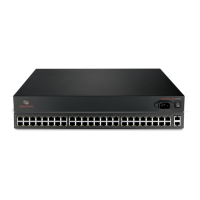Chapter 1: Introduction 9
• By IPDU sequence, identified with alphabetic characters. The first IPDU is A and the
second is B and so forth. Precede the character with a hyphen. For example, !ttyS3-B[6]
would also refer to the sixth outlet on the second IPDU in the chain connected to port 3.
Hostname Discovery
An administrator can configure hostname discovery on the console server. When hostname
discovery is enabled for a serial port, the console server attempts to discover the hostname of the
server connected to the port. If the hostname of a server is successfully discovered, the hostname of
the device connected to it is shown as the serial port alias.
If the server is later moved to another port, and the new port is also configured for hostname
discovery, the hostname for the server is again discovered at the new serial port.
See To configure hostname discovery: on page 80 for more information.
NOTE: If the console server is being managed through DSView 3 software, hostname discovery can be
configured through the DSView 3 software.
An administrator can also configure site-specific probe and answer strings. These strings are used
to probe the target device that is connected to the selected serial port and extract the hostname from
the answer that is received in response to the probe string. The result of each probe string is
matched against all answer strings. If no match is found, the next probe string is sent until there are
no more probe strings or a match occurs. See To configure hostname discovery probe and answer
strings [Expert]: on page 91. The default strings have a broad range and work in most cases.
NOTE: Probe string configuration requires knowledge of C-style escape sequences. Answer strings require
knowledge of POSIX extended regular expressions. Hostnames longer than 31 characters are truncated when
the hostname is assigned to the serial port alias.

